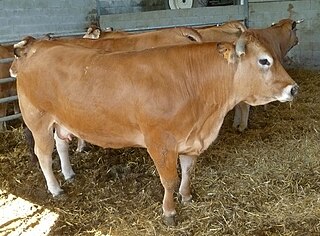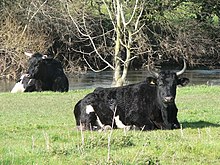
The Canchim is a breed of beef cattle developed in Central Brazil by crossing European Charolais cattle with Indubrazil cattle already kept in Brazil where Asian Zebu type cattle are best suited to the tropical conditions. When compared with Zebu bulls, Canchim bulls produce the same number of calves, but heavier and of superior quality. Compared to European breeds, the Canchim bull produces calves with the same weight but in larger numbers. The fast-growing progeny, from crossbred zebu cows with Canchim bulls, can be slaughtered at 18 months old from feedlots after weaning, up to 24 months old from feedlots after grazing and at 30 months from grazing on the range.

The Red Poll is a dual-purpose breed of cattle developed in England in the latter half of the 19th century. The Red Poll is a cross of the Norfolk Red beef cattle and Suffolk Dun dairy cattle breeds.

The Highland is a Scottish breed of rustic cattle. It originated in the Scottish Highlands and the Western Islands of Scotland and has long horns and a long shaggy coat. It is a hardy breed, able to withstand the intemperate conditions in the region. The first herd-book dates from 1885; two types – a smaller island type, usually black, and a larger mainland type, usually dun – were registered as a single breed. It is reared primarily for beef, and has been exported to several other countries.

The Aberdeen Angus, sometimes simply Angus, is a Scottish breed of small beef cattle. It derives from cattle native to the counties of Aberdeen, Banff, Kincardine and Angus in north-eastern Scotland. In 2018 the breed accounted for over 17% of the beef production in the United Kingdom.

The Holstein Friesian is an international breed or group of breeds of dairy cattle. It originated in Frisia, stretching from the Dutch province of North Holland to the German state of Schleswig-Holstein. It is the dominant breed in industrial dairy farming worldwide, and is found in more than 160 countries. It is known by many names, among them Holstein, Friesian and Black and White.

The Brahman is an American breed of zebuine-taurine hybrid beef cattle. It was bred in the United States from 1885 using cattle originating in India, imported at various times from the United Kingdom, India, and Brazil. These were mainly Gir, Guzerá and Nelore stock, with some Indu-Brasil, Krishna Valley and Ongole. The Brahman has a high tolerance of heat, sunlight and humidity, and good resistance to parasites. It has been exported to many countries, particularly in the tropics; in Australia it is the most numerous breed of cattle. It has been used in the creation of numerous taurine-indicine hybrids, some of which – such as the Brangus and Brahmousin – are established as separate breeds.

The Galloway is a Scottish breed of beef cattle, named after the Galloway region of Scotland, where it originated during the seventeenth century.

Dairy cattle are cattle bred with the ability to produce large quantities of milk, from which dairy products are made. Dairy cattle generally are of the species Bos taurus.

The Dairy Shorthorn is a British breed of dairy cattle. It derives from the Shorthorn cattle of Teesside, in the North Riding of Yorkshire and in Northumbria in north-eastern England. The Shorthorn was for this reason at first known as the Durham or Teeswater.

The Dexter is an Irish breed of small cattle. It originated in the eighteenth century in County Kerry, in south-western Ireland, and appears to be named after a man named Dexter, who was factor of the estates of Lord Hawarden on Valentia Island. Until the second half of the nineteenth century it was considered a type within the Kerry breed.

The Murray Grey is an Australian breed of polled beef cattle. It originated between 1905 and 1917 in the upper Murray River valley, on the border between New South Wales and Victoria. It is similar in appearance to the Aberdeen Angus, from which it largely derives, but is grey, silver or dun in colour.

The Afrikaner or Africander is an African breed of taurine-indicine cattle in the Sanga group of African cattle. It is derived from the cattle of the Khoikhoi (Hottentot) people which were already present in the area of modern South Africa when the Dutch East India Company established the Cape Colony in 1652.

The Belted Galloway is a traditional Scottish breed of beef cattle. It derives from the Galloway stock of the Galloway region of south-western Scotland, and was established as a separate breed in 1921. It is adapted to living on the poor upland pastures and windswept moorlands of the region. The exact origin of the breed is unclear, although the white belt for which they are named, and which distinguishes the breed from black Galloway cattle, is often surmised to be the result of cross-breeding with the similarly coloured Dutch Lakenvelder.

The Senepol breed of beef cattle was developed on the Caribbean Island of St. Croix. It has long been thought that Senepol originated from just crosses between N'Dama cattle, imported in the late 19th century, and Red Poll cattle, but it is actually an admixed breed that consists of Red Poll, N'Dama, Criola and a trace amount of Zebu. The Senepol breed combines characteristics of heat tolerance and insect resistance with the docile nature, good meat, and high milk production of the Red Poll. They are polled, short haired, and colored red, black or brown.

The Limousin, French: Limousine, is a French breed of beef cattle from the Limousin and Marche regions of France. It was formerly used mainly as a draught animal, but in modern times is reared for beef. A herd-book was established in France in 1886. With the mechanisation of agriculture in the twentieth century, numbers declined. In the 1960s there were still more than 250 000 head, but the future of the breed was not clear; it was proposed that it be merged with the other blonde draught breeds of south-western France – the Blonde des Pyrénées, the Blonde de Quercy and the Garonnaise – to form the new Blonde d'Aquitaine. Instead, a breeders' association was formed; new importance was given to extensive management, to performance recording and to exports. In the twenty-first century the Limousin is the second-most numerous beef breed in France after the Charolais. It is a world breed, raised in about eighty countries round the world, many of which have breed associations.

The Shorthorn breed of cattle originated in the North East of England in the late eighteenth century. The breed was developed as dual-purpose, suitable for both dairy and beef production; however, certain blood lines within the breed always emphasised one quality or the other. Over time, these different lines diverged, and by the second half of the twentieth century, two separate breeds had developed – the Beef Shorthorn, and the Milking Shorthorn. All Shorthorn cattle are coloured red, white, or roan, although roan cattle are preferred by some, and completely white animals are not common. However, one type of Shorthorn has been bred to be consistently white – the Whitebred Shorthorn, which was developed to cross with black Galloway cattle to produce a popular blue roan crossbreed, the Blue Grey.
The Buelingo is a modern American composite breed of belted beef cattle, created in North Dakota, in the United States. It is named for Russ Bueling, who owned the foundation stock in the early 1970s.

The Australian Lowline is a modern Australian breed of small, polled beef cattle. It was the result of a selective breeding experiment using black Aberdeen Angus cattle at the Agricultural Research Centre of the Department of Agriculture of New South Wales at Trangie. It is among the smallest breeds of cattle, but is not a dwarf breed.

The Parthenaise is a French breed of beef cattle. It is named for the town of Parthenay in the département of Deux-Sèvres, in the Nouvelle-Aquitaine region of western France. It was formerly a triple-purpose breed, raised for milk, meat and draught work, but is now raised mainly for beef.

The Gasconne or Gascon is a French breed of beef cattle. It is named for the historic region of Gascony and is particularly associated with the Haute-Garonne, in the south-east of that region.



















